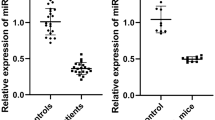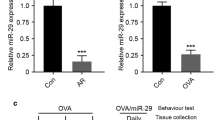Abstract
Background
Regulatory cells (Tregs) have been proved to be deeply involved in allergic airway inflammation. This study aims to evaluate the expression of miRNA in children with AR and their association with Tregs as well as the severity of AR.
Methods
Twenty-five AR children and 20 healthy children were enrolled in this study. The Treg-cell percentage and expression of IL-10 and TGF-β were detected by flow cytometry and enzyme-linked immunosorbent assay. The microRNA microarray analysis in purified Tregs was performed and differentially expressed microRNAs were confirmed by quantitative polymerase chain reaction (qPCR).
Results
Children with AR had lower percentage of Tregs and expression of IL-10 and TGF-beta compared with control children. We found that significantly lower levels of miR-155 and miR-181a in Tregs from AR than healthy controls. Furthermore, intracellular miR-155 and miR-181a level were positively correlated with percentage of Tregs and expression of IL-10 and TGF-beta. Similarly, total nasal severity scores (TNSS) were found to be negatively correlated with miR-155 and miR-181a levels.
Conclusion
Decreased Treg-derived miR-181a and miR-155 were correlated with reduced number and function of Tregs in AR children. The intracellular miR-155 and miR-181a levels may serve as predictors of disease severity in childhood AR.



Similar content being viewed by others
References
Solelhac G, Charpin D (2014) Management of allergis rhinitis. F1000Prime Rep 6:1–6
Tharpe CA, Kemp SF (2015) Pediatric allergic rhinitis. Immunol Allergy Clin N Am 35:185–198
Scadding GK (2015) Optimal management of allergic rhinitis. Arch Dis Child 100:576–582
Wisniewski JA, Borish L (2011) Novel cytokines and cytokine-producing T cells in allergic disorders. Allergy Asthma Proc 32:83–94
Lewkowich IP, Herman NS, Schleifer KW et al (2005) CD4 + CD25 + T cells protect against experimentally induced asthma and alter pulmonary dendritic cell phenotype and function. J Exp Med 202:1549–1561
Kearley J, Barker JE, Robinson DS, Lloyd CM (2005) Resolution of airway inflammation and hyperreactivity after in vivo transfer of CD4 + CD25 + regulatory T cells is interleukin 10 dependent. J Exp Med 202:1539–1547
Askenasy N, Kaminitz A, Yarkoni S (2008) Mechanisms of T regulatory cell function. Autoimmun Rev 7:370–375
Bartel DP (2004) MicroRNAs: genomics, biogenesis, mechanism, and function. Cell 116:281–297
Lu LF, Boldin MP, Chaudhry A, Lin LL, Taganov KD, Hanada T, Yoshimura A, Baltimore D, Rudensky AY (2010) Function of miR-146a in controlling Treg cell-mediated regulation of Th1 responses. Cell 142:914–929
Liston A, Lu LF, O’Carroll D, Tarakhovsky A, Rudensky AY (2008) Dicer-dependent microRNA pathway safeguards regulatory T cell function. J Exp Med 205:1993–2004
Zhou X, Jeker LT, Fife BT, Zhu S, Anderson MS, McManus MT, Bluestone JA (2008) Selective miRNA disruption in T reg cells leads to uncontrolled autoimmunity. J Exp Med 205:1983–1991
Kelada S, Sethupathy P, Okoye IS, Kistasis E, Czieso S, White SD, Chou D, Martens C, Ricklefs SM, Virtaneva K, Sturdevant DE, Porcella SF, Belkaid Y, Wynn TA, Wilson MS (2013) miR-182 and miR-10a are key regulators of Treg specialisation and stability during Schistosome and Leishmania-associated inflammation. PLoS Pathog 9:e1003451
Kohlhaas S, Garden OA, Scudamore C, Turner M, Okkenhaug K, Vigorito E (2009) Cutting edge: the Foxp3 target miR-155 contributes to the development of regulatory T cells. J Immunol 182:2578–2582
Zheng Y, Josefowicz SZ, Kas A, Chu TT, Gavin MA, Rudensky AY (2007) Genome-wide analysis of Foxp3 target genes in developing and mature regulatory T cells. Nature 445:936–940
Shaoqing Y, Ruxin Z, Guojun L, Zhiqiang Y, Hua H, Shudong Y et al (2011) Microarray analysis of differentially expressed microRNAs in allergic rhinitis. Am J Rhinol Allergy 25:e242–e246
Brozek JL, Bousquet J, Baena-Cagnani CE, Bonini S, Canonica GW, Casale TB, van Wijk RG, Ohta K, Zuberbier T, Schünemann HJ (2010) Global allergy and asthma European Network. Grading of recommendations assessment, development and evaluation working Group. AllergicRhinitis and its Impact on Asthma (ARIA) guidelines: 2010 revision. J Allergy Clin Immunol 126:466–476
Liu W, Xia W, Fan Y, Wang H, Zuo K, Lai Y et al (2012) Elevated serum osteopontin level is associated with blood eosinophilia and asthma comorbidity in patients with allergic rhinitis. J Allergy Clin Immunol 130:1416–1418.e6
Chen W, Jin W, Hardegen N, Lei KJ, Li L, Marinos N, McGrady G, Wahl SM (2003) Conversion of peripheral CD4 + CD25- naive T cells to CD4 + CD25 + regulatory T cells by TGF-beta induction of transcription factor Foxp3. J Exp Med 198:1875–1886
Ciprandi G, Fenoglio D, Cirillo I, Vizzaccaro A, Ferrero A, Tosca MA, Puppo F (2005) Induction of interleukin 10 by sublingual immunotherapy for house dust mites: a preliminary report. Ann Allergy Asthma Immunol 95:38–44
O’Connell RM, Rao DS, Chaudhuri AA, Baltimore D (2010) Physiological and pathological roles for microRNAs in the immune system. Nat Rev Immunol 10:111–122
Suojalehto H, Lindström I, Majuri ML, Mitts C, Karjalainen J, Wolff H et al (2014) Altered microRNA expression of nasal mucosa in long-term asthma and allergic rhinitis. Int Arch Allergy Immunol 163:168–178
Levänen B, Bhakta NR, Torregrosa Paredes P, Barbeau R, Hiltbrunner S, Pollack JL et al (2013) Altered microRNA profiles in bronchoalveolar lavage fluid exosomes in asthmatic patients. J Allergy Clin Immunol 131:894–903.e8
Ruggiero T, Trabucchi M, De Santa F, Zupo S, Harfe BD, McManus MT, Rosenfeld MG, Briata P, Gherzi R (2009) LPS induces KH-type splicing regulatory protein-dependent processing of micro-RNA-155 precursors in macrophages. FASEB J 23:2898–2908
Blüml S, Bonelli M, Niederreiter B, Puchner A, Mayr G, Hayer S, Koenders MI, van den Berg WB, Smolen J, Redlich K (2011) Essential role of microRNA-155 in the pathogenesis of autoimmune arthritis in mice. Arthritis Rheum 63:1281–1288
Li QJ, Chau J, Ebert PJ et al (2007) miR-181a is an intrinsic modulator of T cell sensitivity and selection. Cell 129:147–161
Neilson JR, Zheng GX, Burge CB, Sharp PA (2007) Dynamic regulation of miRNA expression in ordered stages of cellular development. Genes Dev 21:578–589
Funding
This study was supported by grants from the National Natural Science Grant of China (No. 81500772), the Guangdong Province Natural Science Grant (Nos. 2014A030310216, 2017A030310150), and the Pearl River S&T Nova Program of Guangzhou (No. 201710010085).
Author information
Authors and Affiliations
Corresponding authors
Ethics declarations
Conflict of interest
The authors declare no conflict of interest.
Research involving human participants
All procedures performed in studies involving human participants were in accordance with the ethical standards of the institutional and/or national research committee and with the 1964 Helsinki declaration and its later amendments or comparable ethical standards.
Informed consent
Informed consent was obtained from all guardians of children included in the study.
Rights and permissions
About this article
Cite this article
Liu, W., Ouyang, H., Zeng, Q. et al. Decreased Treg-derived miR-181a and miR-155 correlated with reduced number and function of Treg cells in allergic rhinitis children. Eur Arch Otorhinolaryngol 276, 1089–1094 (2019). https://doi.org/10.1007/s00405-019-05304-z
Received:
Accepted:
Published:
Issue Date:
DOI: https://doi.org/10.1007/s00405-019-05304-z




